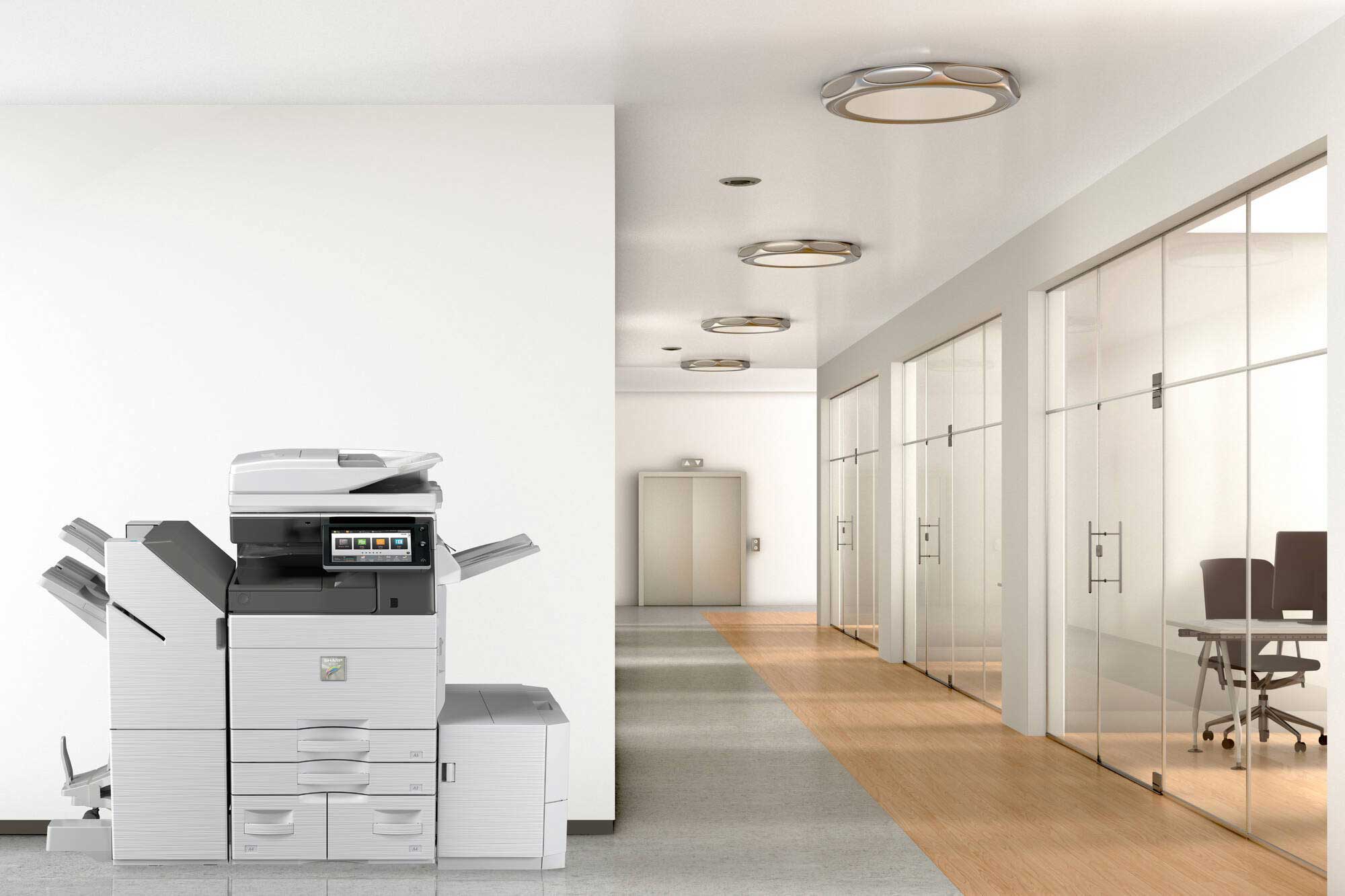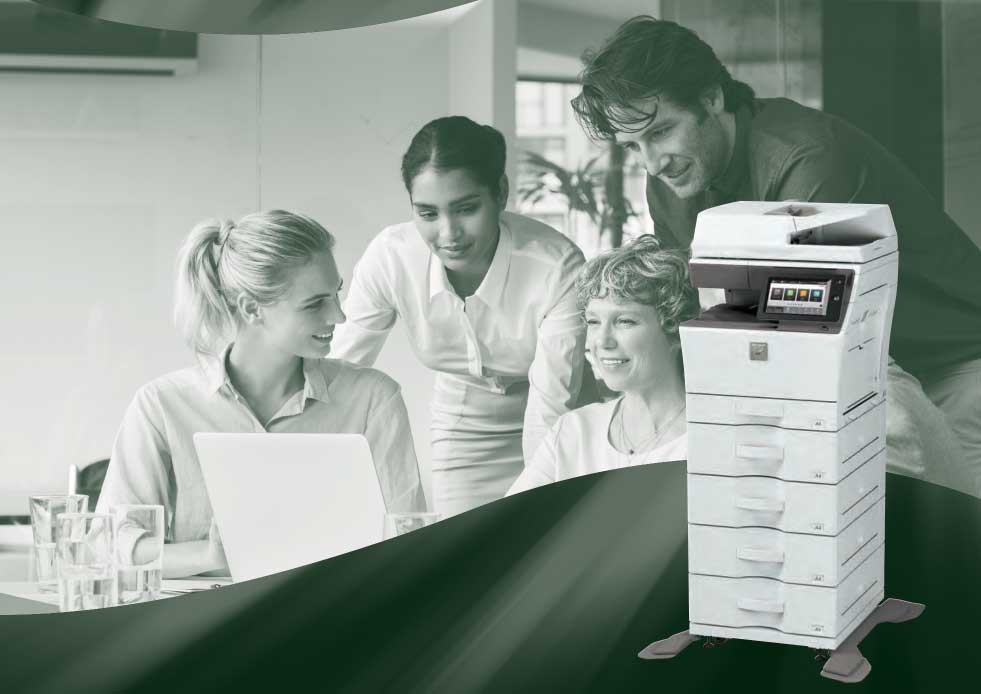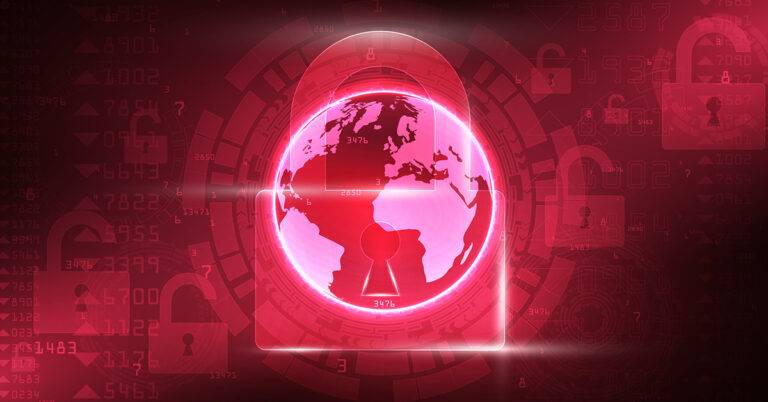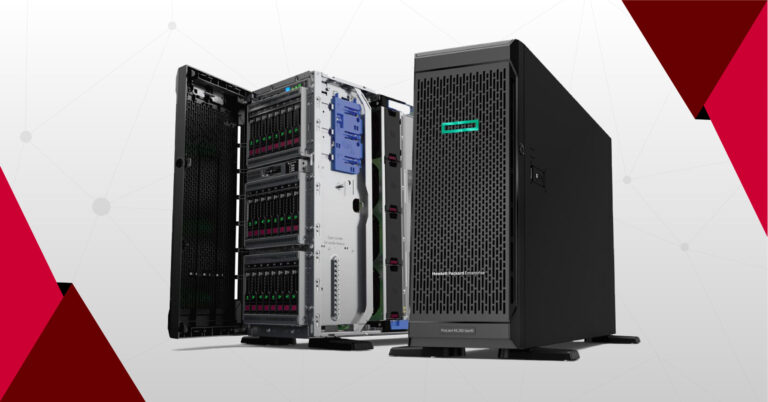Overlooked Printer Security
In today’s digital age, where data breaches and cybersecurity threats loom, safeguarding every aspect of business technology is imperative. Many companies are moving towards Industry 4.0 requiring networked advanced technology for smart sensors, big data analytics, and cloud computing.1 Often overlooked, printers can be vulnerable entry points for security breaches. Printers require as much security as laptops and other network devices.2 Securing printers involves a multifaceted approach encompassing various elements to mitigate risks effectively. This article provides ten elements of printer security for businesses and organizations as a comprehensive guide for prioritizing printer network security efforts.

Printer Security Elements
#1 Access Control
Access control is a critical aspect of printer security. It involves managing and regulating who can access printing resources, controlling their actions, and ensuring that only authorized users can interact with the printers. This multifaceted approach includes several components to fortify access control measures within a business’s printing infrastructure.3
Authentication
Implementing robust authentication mechanisms ensures only authorized individuals can access the printer’s functionalities. Multi-factor authentication adds an extra layer of security by requiring additional verification beyond passwords. Standard authentication methods include the following:
- Passwords: Implementing strong password policies to prevent unauthorized access.
- Biometric Authentication: Utilizing fingerprint or retina scans for heightened security.
- Smart Cards or RFID Tokens: Requiring physical cards or tokens for access.
- Multi-Factor Authentication (MFA): Adding an extra layer of protection by combining two or more authentication methods.
Authorization
Authorization involves granting appropriate permissions to authenticated users based on their organizational roles or responsibilities. It determines what actions a user can perform once authenticated, such as printing, scanning, or managing printer settings. Define and enforce access privileges for users, limiting their activities within the printer’s ecosystem based on their organizational roles and responsibilities. Authorization methods include the following elements:
- Role-Based Access Control (RBAC): Assigning access rights based on predefined organizational roles.
- Access Control Lists (ACLs): Specifying permissions for specific users or user groups.
- Least Privilege Principle: Granting the minimum level of access necessary for users to perform their tasks, reducing the risk of unauthorized actions.
User Access Levels
Establish different levels of access based on job roles, allowing employees access only to the functionalities required for their tasks. Two common examples of limiting access are below:
- Standard User: Access is limited to essential printing functions.
- Administrator: Granted access to manage printer settings and configurations.
Secure Login
Encourage using secure login practices such as regular password updates and avoiding default or easily guessable passwords. Mandating the utilization of regular password updates enhances network security. Provide prompts to the user to create unique passwords to avoid using default credentials.
Role-Based Access Control (RBAC)
RBAC assigns permissions to roles within the organization, streamlining access management and reducing the risk of unauthorized access. Implementing RBAC to ensure that users have access only to the functionalities and resources necessary for their roles minimizes the risk of unauthorized actions or data breaches.
Access Logs
Maintain detailed logs of printer access, document user activities for audit purposes, and detect any suspicious behavior. Maintaining comprehensive access logs to track and monitor user activities enables administrators to review who accessed the printer, when, and what actions occurred. Access logs facilitate auditing, compliance, and identifying potential security incidents.
Implementing robust access control measures is fundamental to fortifying printer security within an organization. By implementing authentication, and authorization, defining user access levels, promoting secure login practices, employing RBAC, and maintaining detailed access logs, businesses can significantly mitigate the risk of unauthorized access and potential security breaches related to their printing infrastructure.

#2 Data Protection
Data protection is crucial in printer security to safeguard sensitive information. Implementing robust measures ensures that data remains confidential, integral, and available only to authorized personnel. Here, critical components of data protection for printer security include the following:
Encryption
Encrypting data ensures that it remains secure during transmission and storage. Employ encryption protocols to protect data both in transit and at rest. Encryption assures sensitive information remains unreadable to unauthorized individuals.4
- Transport Layer Security (TLS) / Secure Sockets Layer (SSL): Encrypt data between devices and printers during transmission.
- Data-at-Rest Encryption: Encrypt data stored on the printer’s hard drive or memory.
Secure Transmission
Secure protocols and methods ensure that data transmitted to and from printers remains protected. Utilize secure transmission protocols like SSL/TLS to safeguard data while it’s being sent from devices to printers and vice versa.
- Encrypted Communication Protocols: Utilizing secure communication protocols like HTTPS or SNMPv3 for secure data transmission.
- VPN for Remote Printing: Establishing a Virtual Private Network (VPN) connection for encrypted and secure remote printing.
Secure Storage
Storage security involves implementing secure storage protocols on printers. These protocols protect stored data from unauthorized access or tampering. Restrict access to stored data to authorized personnel only.
- Encryption of Stored Data: Encrypt data stored on the printer’s internal memory or hard drive.
- Access Controls for Stored Data: Implement access controls to limit privileges to stored data to only the personnel who require the information to complete their work.
Data Masking
Mask sensitive information on printed documents to prevent unauthorized viewing or retrieval of critical data. Redact sensitive data. Before printing, provide automated redacting or obscuring of sensitive information, such as personal identifiers or confidential data.
Secure Printing
Utilize secure features such as pull printing or PIN codes, ensuring documents are released only to the intended recipients. Implementing secure printing methods ensures that records remain secure.
- Pull Printing: Requiring users to authenticate at the printer before the document prints, preventing unauthorized access to printed documents.
- PIN or Password Protection: Releasing printed documents only after entering a unique PIN or password at the printer.
Continuous Data Protection
Establishing continuous monitoring and protection mechanisms to prevent data breaches or leaks:
- Real-time Monitoring: Monitoring printer activities in real-time to detect and respond to potential security threats immediately.
- Vulnerability Scanning: Conducting regular vulnerability scans to identify weaknesses and address potential security gaps in printer systems.
Data Loss Prevention (DLP)
Deploy DLP solutions to prevent sensitive data from being printed without proper authorization. DLP practices minimize the risk of data leaks. Two examples of DLP practices are below:
- Content Inspection: Analyzing print jobs to detect and prevent the printing of confidential or prohibited data.
- Policy-Based Controls: Implementing policies that restrict the printing of specific categories of sensitive information.
Data protection measures are essential to ensure the confidentiality and integrity of sensitive information processed by printers. Employing encryption, securing data during transmission and storage, implementing secure printing methods, and deploying continuous monitoring are crucial steps in fortifying printer security and mitigating the risk of data breaches.

#3 Network Security
Securing printers within a network environment is pivotal in maintaining overall network security. Printers, often overlooked, can be vulnerable entry points for cyber threats. Ensuring their security involves several vital components that intersect with broader network security measures.
Firewall Settings
Configure and regularly update firewall settings to monitor and control incoming and outgoing network traffic to and from printers. Consistent management and control of inbound and outbound printer traffic helps keep networks secure.
- Port Filtering: Restricting specific ports to prevent unauthorized access to printer services.
- Traffic Inspection: Analyzing and filtering network traffic to detect and block suspicious activity.
Intrusion Detection/Prevention
Implement intrusion detection and prevention systems to identify and block suspicious activities or unauthorized access. Detection systems identify and respond to potential security breaches and prevent unauthorized access attempts by would-be cyberthieves.
- Anomaly Detection: Monitoring printer network traffic for unusual patterns that may indicate malicious activity.
- Real-Time Alerts: Generating alerts and notifications for potential security incidents for immediate response.
VLAN Segmentation
Isolate printers on separate VLANs to contain potential security breaches and limit access to sensitive network segments. Place printers into different Virtual Local Area Networks (VLANs) to enhance security.
- Network Segregation: Keeping printers on dedicated VLANs to limit their exposure to other network segments.
- Access Control: Setting up access control lists to regulate communication between VLANs and other network devices.
Secure Protocols
Use secure communication protocols like HTTPS and SNMPv3 to encrypt data transmitted between printers and connected devices.
- HTTPS for Web Interface: Ensuring the printer’s web interface uses HTTPS to encrypt data in transit.
- Secure Management Protocols: Employing secure protocols like SNMPv3 for secure printer management.
Network Isolation
Implement network segmentation strategies to separate printer networks from other business networks. Network isolation reduces the possible attack surface.
- Segmentation Policies: Defining network segmentation policies to isolate printers from sensitive network areas.
- Access Controls: Restricting access to printer networks based on user roles and responsibilities.
Patching and Updates
Set up regular patching and firmware updates. Ensuring printers receive periodic firmware updates addresses known vulnerabilities. Regular patching improves overall security.
Security Configuration Review
Periodically reviewing and updating printer security configurations aligns your network with evolving cybersecurity best practices.
Access Control Lists (ACLs)
Implementing ACLs controls traffic flow to and from printers. Access control restricts unauthorized access.

#4 Device Security
Firmware Updates
Regularly update printer firmware to patch known vulnerabilities and improve overall device security.
Physical Security Measures
Secure printers physically by placing them in restricted access areas and implementing measures like locks or access cards to prevent tampering or theft.
Secure Boot Process
Ensure printers undergo a secure boot process to verify the integrity of the firmware and detect any unauthorized modifications.
Configuration Management
Apply strict configuration management practices to maintain a secure and standardized setup across all printers in the network.
Anti-Tampering Mechanisms
Incorporate anti-tampering features to detect and prevent unauthorized modifications to printer hardware or software components.

#5 Monitoring and Management
Monitoring and managing printers effectively are vital components of a comprehensive security strategy within an organization. Robust monitoring and management practices enable proactive identification of potential security threats, timely responses to incidents, and adherence to security policies. Below is a breakdown of essential elements for monitoring and managing printer security.
Security Auditing
Conduct regular security audits to identify vulnerabilities, assess risks, and ensure compliance with established security protocols. Below are two assessments often used for auditing printer security.
- Periodic Assessments: Perform scheduled audits to evaluate printer security configurations, access controls, and compliance with security policies.
- Vulnerability Assessments: Identify potential vulnerabilities within the printer infrastructure and address them promptly.
Incident Response
Develop and implement incident response plans to address security breaches promptly and minimize their impact on the organization. Two procedures that help limit a security intrusion follow:
- Periodic Assessments: Perform scheduled audits to evaluate printer security configurations, access controls, and compliance with security policies.
- Vulnerability Assessments: Identify potential vulnerabilities within the printer infrastructure and address them promptly.
Real-Time Monitoring
Use real-time monitoring tools to track printer activities and detect anomalies or potential security threats.
- Event Logging: Collecting and analyzing logs of printer-related events to detect suspicious activities or anomalies.
- Automated Alerts: Setting up alerts for unusual behavior or security breaches to enable immediate response.
Centralized Management
Centralize printer management through dedicated systems to streamline security configurations and updates across the entire printer fleet.
- Unified Management Console: Using dedicated software to manage and monitor multiple printers centrally.
- Policy Enforcement: Implementing consistent security policies across all printers within the organization.
Vulnerability Scanning
Perform regular vulnerability scans to proactively identify weaknesses and address potential security gaps in printer systems.
- Scheduled Scans: Conduct routine vulnerability scans to identify and address potential security gaps.
- Patch Management: Ensuring timely application of security patches and updates based on scan results.

#6 Compliance and Standards
Compliance with industry regulations and adherence to established security standards are fundamental to ensuring printer security within an organization. Implementing measures to meet regulatory requirements and following industry standards helps fortify printer security and protect sensitive information. Below is a description of how compliance and standards intersect with printer security:
GDPR, HIPAA, or Other Regulatory Compliance
Adhere to industry-specific regulations by implementing security measures that safeguard sensitive data printers process.
- Data Protection Regulations (e.g., GDPR): Ensure printers handle personal data in compliance with data protection regulations, including secure data processing and storage.
- Healthcare Compliance (e.g., HIPAA): Implement security measures for printers handling sensitive healthcare information, including patient records.
Industry Standards
Follow established security framework guidelines to align printer security practices with recognized industry standards.
- ISO 27001: Aligning printer security practices with the ISO/IEC 27001 standard for information security management systems.
- NIST Guidelines: Implementing security measures based on recommendations from the National Institute of Standards and Technology (NIST) for enhanced cybersecurity.
Security Policy Enforcement
Enforce strict security policies defining acceptable use, access control, and printer data handling practices.
- Policy Development: Creating comprehensive security policies that cover printer access controls, data handling, and incident response procedures.
- Policy Review and Updates: Regularly reviewing and updating security policies to align with evolving threats and compliance requirements.
Compliance Assessments
Regularly assess compliance with security standards and regulations to ensure adherence and identify areas for improvement.
- Regular Audits: Perform routine audits and assessments to evaluate the effectiveness of printer security controls and practices.
- Compliance Reporting: Generating reports to demonstrate compliance with regulations and standards.
Adhering to regulatory requirements such as GDPR, HIPAA, or industry standards like ISO 27001 and NIST guidelines ensures that printer security measures align with best practices and legal obligations. By implementing security policies, undergoing regular compliance assessments, and aligning security practices with established standards, organizations can mitigate risks and maintain the integrity of their printer security with regulatory mandates and industry benchmarks.

#7 User Education and Awareness
User education and awareness are pivotal in bolstering printer security within an organization. Educating employees about potential risks, best practices, and their responsibilities regarding printer usage is essential in mitigating security threats. User education and awareness contribute to printer security through the following:
Security Training
Provide comprehensive security training to employees, educating them on printer security best practices and potential threats.
- Security Protocols: Educating users on secure printing procedures, including authentication methods and data protection measures.
- Recognizing Threats: Training employees to identify potential security threats to printers, such as phishing attacks or unauthorized access attempts.
Best Practices
Promote and reinforce best practices related to printer security, emphasizing the importance of secure printing habits.
- Secure Printing Guidelines: Communicating guidelines for handling sensitive documents and utilizing secure printing options.
- Password Management: Encouraging strong password practices and regular password updates for printer access.
Phishing Awareness
Educate users about phishing threats targeting printers and raise awareness about recognizing and avoiding such attacks.
- Phishing Simulation Training: Conduct simulated phishing exercises to familiarize users with common tactics and how to recognize and report phishing attempts related to printers.
- Email Security: Emphasize verifying sender authenticity before interacting with printer-related emails.
Policy Acknowledgment
Require employees to acknowledge and adhere to printer security policies as part of their employment agreements.
- Policy Acceptance: Employees must acknowledge and accept printer security policies as part of their onboarding process.
- Regular Policy Reviews: Remind users to review and acknowledge updates or changes to security policies related to printer usage.
User Responsibility
Empower employees to take responsibility for maintaining printer security by encouraging vigilance and reporting suspicious activities.
- Vigilance and Reporting: Encouraging employees to promptly report any suspicious printer-related activities or potential security breaches.
- Role-based Training: Tailoring training sessions based on specific user roles and responsibilities concerning printer usage.
Organizations can significantly enhance printer security by investing in comprehensive security training, promoting best practices, raising awareness about phishing threats, ensuring policy acknowledgment, and encouraging user responsibility. A well-informed and vigilant workforce contributes to a collective effort to mitigate security risks and maintain a secure printing environment.

#8 Remote Printing and Mobile
Securing printers in the context of remote printing and mobile access is crucial due to the increasing trend of remote work and the use of mobile devices. Ensuring that remote access to printers is secure helps protect sensitive data and maintain overall printer security. Address printer security concerns in remote printing and mobile environments through the following measures:
Mobile Device Management (MDM)
Implement MDM solutions to manage and secure mobile devices accessing printers, ensuring compliance with security policies.
- Device Authentication: Enforcing authentication measures on mobile devices to access printers securely.
- Policy Enforcement: Applying security policies to mobile devices to ensure compliance with printer security protocols.
Secure Mobile Printing
Enable secure printing from mobile devices by implementing authentication methods and encryption protocols.
- Authentication Protocols: Require user authentication and authorization for printing from mobile devices.
- Encrypted Communication: Encrypt data from mobile devices to printers for secure printing.
VPN Access
Require secure VPN connections for remote printer access, adding an extra layer of encryption and authentication.
- Encrypted Communication: Direct remote printer access through encrypted VPN connections to protect data in transit.
- Access Control: Enforcing access controls via VPN policies to allow only authorized users to connect to printers remotely.
Remote Access Policies
Establish clear policies and protocols for remote printer access, defining acceptable practices and security measures.
- Access Permissions: Defining and communicating access rules and restrictions for remote printing.
- User Training: Providing guidelines to remote users on securely accessing and using printers outside the corporate network.
Incorporating measures like mobile device management, secure mobile printing, VPN access for remote connections, and defining clear remote access policies strengthens printer security in remote and mobile environments. By ensuring that mobile devices adhere to security protocols, enforcing encrypted communication, and implementing robust access controls, organizations can minimize security risks associated with remote printing and mobile access to printers.

#9 Supplier and Third-Party
Addressing printer security concerning suppliers and third-party involvement is crucial to safeguarding the overall integrity of an organization’s printing infrastructure. The emerging use of additive manufacturing and Industry 4.0 technologies within new business models brings additional security challenges with sharing data between the company and its customers and vendors. Engaging with external entities requires a vigilant approach to ensure third-party contributions do not compromise printer security.5 Below is how to manage printer security with suppliers and third-party involvement:
Vendor Security Assessments
Conduct thorough security assessments of printer vendors to ensure they meet security standards and address potential risks.
- Security Standards: Assess whether vendors adhere to recognized security standards and certifications.
- Vendor Risk Evaluation: Evaluate the potential risks of utilizing products or services from particular vendors.6
Supply Chain Security
Monitor and secure the supply chain to prevent compromise at any stage, ensuring the integrity of printer hardware and software.
- Supplier Verification: Verify suppliers’ security practices, ensuring they meet security criteria before engaging in partnerships.
- Supply Chain Transparency: Ensuring transparency in the supply chain process to track and mitigate potential security risks.
Third-Party Integrations
Assess the security implications of third-party integrations with printer systems and implement measures to mitigate associated risks.
- Integration Security Checks: Conduct thorough security assessments before integrating third-party applications or solutions with printer systems.
- Data Access Controls: Implement measures to control access and permissions granted to third-party entities interacting with printer systems.
Contractual Security Obligations
Include specific security clauses in contracts with vendors and third parties to enforce compliance with security standards.
- Security Clause Inclusions: Incorporate specific security clauses in contracts to outline security requirements and obligations.
- Compliance Verification: Regularly verifying that vendors and third parties comply with contractual security provisions.
Organizations can mitigate potential risks associated with supplier and third-party involvement in printer security by performing vendor security assessments, securing the supply chain, carefully integrating third-party solutions, and enforcing security obligations through contractual agreements. Maintaining stringent security measures when collaborating with external entities is crucial to safeguarding the integrity and confidentiality of printer systems and data.

#10 Physical Environment
Securing printers within the physical environment is as crucial as implementing digital security measures. Protecting printers in their physical space mitigates risks related to unauthorized access, data breaches, and environmental hazards. Here’s how to ensure printer security in the physical environment:
Secure Disposal of Printouts
Implement secure disposal practices for printed documents to prevent unauthorized access to sensitive information.
- Shredding or Destruction: Establishing protocols for shredding or secure destruction of sensitive documents.
- Secure Bins or Containers: Providing designated containers for confidential document disposal.
Secure Printer Locations
Place printers in secure, controlled-access areas to prevent physical tampering or unauthorized use.
- Restricted Access Areas: Install printers in areas with limited access, using locks or access cards to control entry.
- Surveillance Measures: Installing security cameras to monitor printer locations.
Access Control to Physical Devices
Restrict physical printer access through access control measures like locks, badges, or biometric authentication.
- Biometric Access: Use biometric authentication (fingerprint, retina scan) to control printer access.
- Access Logs: Log physical access to printers to track who interacts with them and when.
Environmental Monitoring
Monitor the physical environment of printers, ensuring optimal conditions, including temperature and humidity, support device functionality, and prevent damage.
- Temperature and Humidity Control: Maintain suitable environmental conditions to prevent damage to printer hardware.
- Security Alarms: Implement alarms for environmental changes that could affect printer performance or data integrity.
Maintenance of Physical Security
Regularly reviewing and reinforcing physical security measures can also contribute to printer security.
- Security Audits: Conduct periodic audits to assess the effectiveness of physical security measures.
- Employee Training: Train staff on physical security practices and safeguarding printer locations.
Implementing comprehensive printer security measures encompassing these ten crucial elements is pivotal in safeguarding sensitive data, mitigating risks, and maintaining the integrity of business operations. An additional benefit of incorporating each of these printer cybersecurity measures in your organization is that they will significantly reduce your cybersecurity insurance costs. Prioritizing printer security protects confidential information and contributes considerably to an organization’s overall cybersecurity posture in today’s threat landscape. Find out more about Printer Security Features and the Top Ranked Printers for Cybersecurity. Additionally, check out this Comprehensive Guide for Printer Cybersecurity.

How does your organization compare with other industry leaders for print security? Assess your network security stance with our Free Aberdeen-driven Printer Security Assessment to ensure you remain ahead of the curve in print and cybersecurity. Stay secure, stay ahead.
Footnotes
- 1Corallo, Angelo, et al. “Cybersecurity challenges for manufacturing systems 4.0: assessment of the business impact level.” IEEE Transactions on Engineering Management (2021). Accessed 9 November 2023. ieeexplore.ieee.org/abstract/document/9457098.
- 2Bella, Giampaolo, and Pietro Biondi. “You overtrust your printer.” Computer Safety, Reliability, and Security: SAFECOMP 2019 Workshops, ASSURE, DECSoS, SASSUR, STRIVE, and WAISE, Turku, Finland, September 10, 2019, Proceedings 38. Springer International Publishing, 2019. Accessed 2 November 2023. link.springer.com/chapter/10.1007/978-3-030-26250-1_21
- 3 Saeed, Saqib, et al. “Digital transformation and cybersecurity challenges for businesses resilience: Issues and recommendations.” Sensors 23.15 (2023): 6666. Accessed 3 November 2023. www.mdpi.com/1424-8220/23/15/6666
- 4Gupta, Nikhil, et al. “Additive manufacturing cyber-physical system: Supply chain cybersecurity and risks.” IEEE Access 8 (2020): 47322-47333. Accessed 2 November 2023. ieeexplore.ieee.org/stamp/stamp.jsp?tp=&arnumber=9026901
- 5 Corallo, Angelo, et al. “Cybersecurity challenges for manufacturing systems 4.0: assessment of the business impact level.” IEEE Transactions on Engineering Management (2021). Accessed 2 November 2023. ieeexplore.ieee.org/abstract/document/9457098
- 6 Adkins, Chris, Stephan Thomas, and Daniel Moore. “Defining and Addressing the Cybersecurity Challenges of Additive Manufacturing Platforms.” Proceedings of the 2021 Workshop on Additive Manufacturing (3D Printing) Security. 2021. Accessed 3 November 2023. dl.acm.org/doi/abs/10.1145/3462223.3485622




